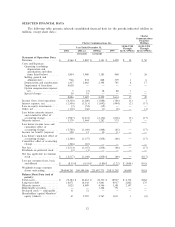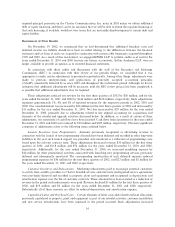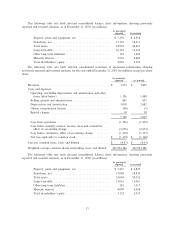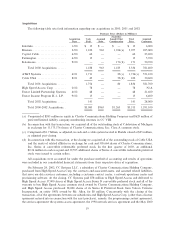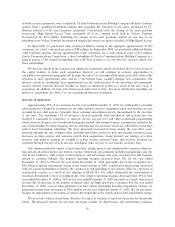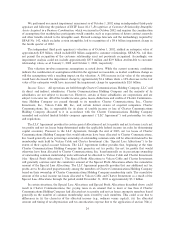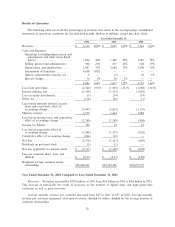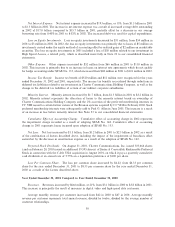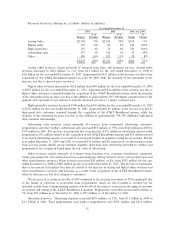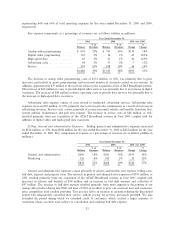Charter 2002 Annual Report Download - page 24
Download and view the complete annual report
Please find page 24 of the 2002 Charter annual report below. You can navigate through the pages in the report by either clicking on the pages listed below, or by using the keyword search tool below to find specific information within the annual report.‚ Customer premise activities performed by in-house Ñeld technicians and third-party contractors in
connection with customer installations, installation of network equipment in connection with the
installation of expanded services and equipment replacement and betterment; and
‚ Verifying the integrity of the customer's network connection by initiating test signals downstream from
the headend to the customer's digital set-top terminal.
We capitalized internal direct labor costs of $173 million, $171 million and $111 million, for the years
ended December 31, 2002, 2001 and 2000, respectively.
Judgment is required to determine the extent to which indirect costs (""overhead'') are incurred as a
result of speciÑc capital activities, and therefore should be capitalized. We capitalize overhead based upon an
allocation of the portion of indirect costs that contribute to capitalizable activities using an overhead rate
applied to the amount of direct labor capitalized. We have established the overhead rates based on an analysis
of the nature of costs incurred in support of capitalizable activities and a determination of the portion of costs
which is directly attributable to capitalizable activities. The primary costs that are included in the
determination of the overhead rate are (i) employee beneÑts and payroll taxes associated with capitalized
direct labor, (ii) direct variable costs associated with capitalizable activities, consisting primarily of
installation and construction vehicle costs, (iii) the cost of support personnel, such as dispatch that directly
assist with capitalizable installation activities, and (iv) indirect costs directly attributable to capitalizable
activities.
While we believe our existing capitalization policies are appropriate, a signiÑcant change in the nature or
extent of our system activities could aÅect management's judgment about the extent to which we should
capitalize direct labor or overhead in the future. We monitor the appropriateness of our capitalization policies,
and perform updates to our internal overhead study on a periodic basis to determine whether facts or
circumstances warrant a change to our capitalization policies. We capitalized overhead of $162 million,
$134 million and $86 million, respectively, for the years ended December 31, 2002, 2001 and 2000.
Useful lives of property, plant and equipment. We evaluate the appropriateness of estimated useful lives
assigned to our property, plant and equipment, and revise such lives to the extent warranted by changing facts
and circumstances. Beginning in January 2000, we commenced a signiÑcant initiative to rebuild and upgrade
portions of our cable network. During 2001 and 2000, we reduced the useful lives of $1.1 billion in 2000 and an
additional $125 million in 2001, of assets expected to be replaced and retired through that process to
approximately one to three years, representing management's best estimate of the expected pattern of the
retirement from service of such assets. A signiÑcant change in assumptions about the extent or timing of
future asset usage or retirements could materially aÅect future depreciation expense.
Depreciation expense related to property, plant and equipment totaled $1.4 billion, $1.2 billion and
$1.0 billion, representing approximately 16%, 24% and 25% of costs and expenses, for the years ended
December 31, 2002, 2001 and 2000, respectively. Of these amounts, approximately $183 million, $352 million
and $674 million, respectively, relates to network assets which were replaced and retired over the three-year
period of the rebuild initiative. Depreciation is recorded using the straight-line method over management's
estimate of the estimated useful lives of the related assets as follows:
Cable distribution systemsÏÏÏÏÏÏÏÏÏÏÏÏÏÏÏÏÏÏÏÏÏÏÏÏÏÏÏÏÏÏÏÏÏÏÏÏÏÏÏÏÏÏ 7-15 years
Customer equipment and installations ÏÏÏÏÏÏÏÏÏÏÏÏÏÏÏÏÏÏÏÏÏÏÏÏÏÏÏÏÏÏÏÏ 3-5 years
Vehicles and equipmentÏÏÏÏÏÏÏÏÏÏÏÏÏÏÏÏÏÏÏÏÏÏÏÏÏÏÏÏÏÏÏÏÏÏÏÏÏÏÏÏÏÏÏÏ 1-5 years
Buildings and leasehold improvementsÏÏÏÏÏÏÏÏÏÏÏÏÏÏÏÏÏÏÏÏÏÏÏÏÏÏÏÏÏÏÏÏ 5-15 years
Furniture and ÑxturesÏÏÏÏÏÏÏÏÏÏÏÏÏÏÏÏÏÏÏÏÏÏÏÏÏÏÏÏÏÏÏÏÏÏÏÏÏÏÏÏÏÏÏÏÏÏ 5 years
Impairment of property, plant and equipment, franchises and goodwill. As discussed above, the net
carrying value of our property, plant and equipment is signiÑcant. We also have recorded a signiÑcant amount
of cost related to franchises, pursuant to which we are granted the right to operate our cable distribution
network throughout our service areas. The net carrying value of franchises as of December 31, 2002 and 2001
was approximately $13.7 billion (representing 61% of total assets) and $18.9 billion (representing 71% of total
22


